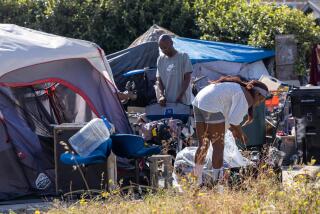BOYLE HEIGHTS : Homeless Population Rises; So Does Crime
- Share via
Under the behemoth concrete girders of the First Street bridge, homeless people are rebuilding their village with wooden pallets and cardboard.
Houston Hodges balanced a pallet over his head recently as he carried it under the bridge and set it down next to his mattress. Just days earlier, on July 19, he and about 40 others who slept in shacks under the soot-covered section of overpass were ordered to leave by police. Then bulldozers crushed their makeshift buildings.
“They came in and they cleaned us up,” said Hodges, a 54-year-old ex-Marine who has lived under the bridge for 2 1/2 years. Now he and seven others have returned to rebuild.
Local police say they disassembled the dwellings because they were built on public property where homeless people often started fires and because unsanitary conditions created a health hazard. Police estimate that the number of transients east of the Los Angeles River’s concrete trough has doubled in the past three months; burglaries by street people rolling shopping carts and complaints from local businesses have risen concurrently. The number of local reported burglaries jumped 46% in the first two weeks of July compared to the same period last year, and Hollenbeck Station detectives say the vast majority have occurred near five large camps alongside the river.
“Wherever there’s a concentration of homeless people, the burglary and robbery rate increases,” Detective John Vach said.
Homeless outreach workers say the number of homeless people countywide--about 70,000 on any given night--continues to grow, and after recent police efforts to shoo along the homeless in Skid Row, more are moving outward into other communities. It is difficult to estimate how many homeless are leaving the central city, but Bob Erlenbusch, executive director of the L.A. Coalition to End Homelessness, said many are finding shelter beneath overpasses near Downtown and figuratively disappearing.
“People who society doesn’t like to see are being pushed further toward being invisible,” Erlenbusch said.
While they may live in obscurity, the homeless have a growing presence in police records at Hollenbeck Station. A transient mug book now holds photographs and interview information about 160 people, about 90% of whom police say are crack cocaine addicts.
In the past six months, Hollenbeck police have begun to confiscate stolen shopping carts because some homeless thieves use them to haul away loot.
One night recently, police say a man pushed a cart down an alley to an ice cream manufacturing plant and tried unsuccessfully to force open its roll-up door. Instead, he climbed in through a skylight.
Inside, police were waiting for him. The stakeout was part of a new strategy started by police during the past month in response to repeated burglaries of particular businesses. Police organized stakeouts to wait for burglars on four consecutive nights one recent week. Detective Dennis Bisdorf said homeless thieves have taken tools, office equipment, sodas--”anything they can fit in their shopping carts.”
But some homeless people complain that when police confiscate their metal-wire vehicles, they are taking away a method of earning money by delivering cans and bottles to recycling facilities.
Hodges lost his cart when the police moved the homeless out from under the First Street bridge, so his only source of income now is work at a nearby frozen food warehouse, where he loads trucks most days.
“I don’t get paid, but I get tips from the truck drivers,” he said.
Hodges said he has to pay a price for being homeless even though he keeps to himself. Standing in the recently razed encampment near an overturned box of limp lettuce and a sleeping body, he had one request: “I wish they’d leave us alone, man.”
More to Read
Sign up for Essential California
The most important California stories and recommendations in your inbox every morning.
You may occasionally receive promotional content from the Los Angeles Times.













